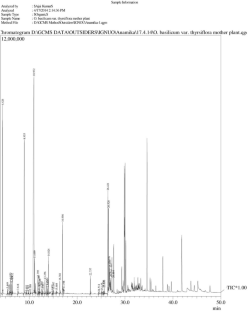Biochemical profiling of in-vitro regenerated and conventionally grown Ocimum basilicum var. thyrsiflora plants
Research Articles | Published: 15 February, 2021
First Page: 138
Last Page: 143
Views: 3869
Keywords: GC–MS, Monoterpenes, Sesquiterpenes, Phenolicterpenes, Terpeneesters
Abstract
Ocimum is an aromatic plant species with immense medicinal properties. It contains several bioactive compounds that are used in the preparation of synthetic drugs. The study is aimed to compare the volatile components of in-vitro raised plants with the donor mother plant. The in-vitro regenerated plants showed 52 volatile compounds, whereas the mother plant showed 41 compounds only. It was observed that in-vitro regenerants consisted of a higher percentage of volatiles (38.92%) as compared to the mother plant (28.8%). Many similar constituents were identified from both the mother plant and in-vitro raised plants such as linalool, camphor, and δ-terpineol. However, some constituents were obtained from in-vitro raised plants only such as α-cubebene, β-chamigrene, trans-calamenene, cubebol, spathulenol, isogermacrene D, cedrol, isocitronellol, cheloviolene D, cis-β-terpeniol, thujol, γ-amorphene, γ-gurjunene, and γ-elemene. Two diterpenes (neocembrene and cheloviolene D) were also present in the in-vitro raised plants. The current study provides an alternative approach for quick synthesis of bioactive products of medicinal and other commercial use.

References
- Amadi JE, Salami SO, Eze CS (2010) Antifungal properties and phytochemical screening of extracts of African Basil (Ocimum gratissimum L.). Agric Biol J N Am 1(2):163–166
- Arafeh RM (1999) Factors affecting in-vitro propagation, callusing, cell suspension culture and secondary metabolites production in sweet marjoram Origanum vulgare L. and Syrian marjoram Majorana syriacum L. Rafin (Origanum syriacum L.). M.Sc. Thesis. Jordan University of Science and Technology, Irbid, Jordan
- Arikat NA, Jawad FM, Karam NS, Shibli RA (2004) Micropropagation and accumulation of essential oils in wild sage (Salvia fruticosa Mill.). Sci Hortic 100:193–202
- Burbott AJ, Loomis WD (1967) Effects of light and temperature on the monoterpenes of peppermint. Plant Physiol 42:20–28
- Campia LC, Pescarmona G, Ghigo D, Bosia A, Riganti C (2009) Geranilgeraniol prevents the cytotoxic effects of mevastatin in THP-1 cells, without decreasing the beneficial effects on cholesterol synthesis. Br J Pharmacol 158:1777–1786
- Charles DJ, Simon JE (1990) Comparison of extraction methods for the rapid determination of essential oil content and composition of basil. J Am Soc Hortic Sci 115(3):458–462
- Deschamps C, Simon JE (2002) Agrobacterium tumefaciens- mediated transformation of Ocimum basilicum and Ocimum citriodorum. Plant Cell Rep 21:359–364
- Gershenzon J, Maffei M, Croteau R (1989) Biochemical and histochemical localization of monoterpene biosynthesis in glandular trichomes of spearmint (Mentha spicata). Plant Physiol 89:1351–1357
- Gherman C, Culea M, Cozar O (2000) Comparative analysis of some active principles of herb plants by GC/MS. Talanta 53:253–262
- Gollo AL, Tanobe VO, de Melo Pereira GV, Marin O, Bonatto SJR, Silva S, de Barros IR, Soccol CR (2020) Phytochemical analysis and biological activities of in-vitro cultured Nidularium procerum, a bromeliad vulnerable to extinction. Sci Rep 10(1):1–13
- Hirata T, Murakami S, Ogihara K, Suga T (1990) Volatile monoterpenoid constituents of the plantlets of Mentha spicata produced by shoot tip culture. Phytochemistry 29(2):493–495
- Livadariu O (2011) Experimental research on in-vitro propagation through direct somatic embryogenesis of basil (Ocimum basilicum L.). Bull UASVM Anim Sci Biotechnol 68(1–2):332–337
- Ncube B, Ngunge VNP, Finnie JF, Staden JV (2011) A comparative study of the antimicrobial and phytochemical properties between outdoor grown and micropropagated Tulbaghia violacea Harv. plants. J Ethnopharmacol 134:775–780
- Proestos C, Sereli D, Komaitis M (2006) Determination of phenolic compounds in aromatic plants by RP-HPLC and GC-MS. Food Chem 95:44–52
- Shahzad A, Siddiqui SA (2000) In-vitro organogenesis in O. sanctum L.- a multipurpose herb. Phytomorphology 50(1):27–35
- Shahzad A, Faisal M, Ahmad N, Anis M, Alatar A, Hend AA (2012) An efficient system for in- vitro multiplication of Ocimum basilicum through node culture. Afr J Biotechnol 11(22):6055–6059
- Simon JE, Morales MR, Phippen WB, Vieira RF, Hao Z (1999) Basil: a source of aroma compounds and a popular culinary and ornamental herb. Reprinted from: perspectives on new crops and new uses, J. Janick (ed.). ASHS Press, Alexandria
- Sudria C, Pinol MT, Palazon J, Cusido RM, Vila R, Morales C, Bonfill M, Canigueral S (1999) Influence of plant growth regulators on the growth and essential oil content of cultured Lavandula dentata plantlets. Plant Cell Tissue Org Cult 58:177–184
- Tahira R (2013) Variation in bioactive compounds in different plant parts of lemon basil (O. basilicum var. citriodorum). Experiment 17(2):1184–1190
Author Information
School of Sciences, Indira Gandhi National Open University, New Delhi, India